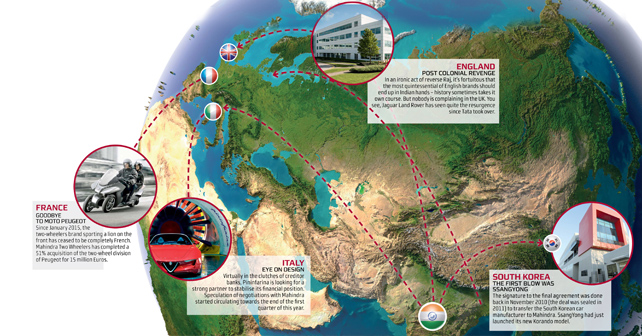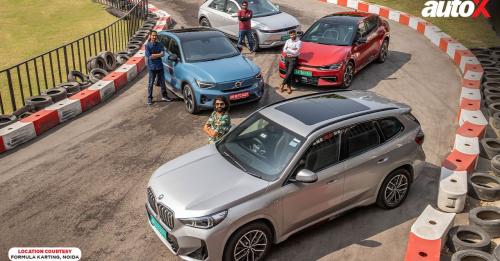Mahindra’s interest in iconic Italian design firm Pininfarina is the latest episode of a fearless expansion strategy being pursued by Indian manufacturers. The Indian auto industry, often considered second string in the West, is making its presence felt…
It’s not Germany or South Korea that’s home to some of the most brilliant and dynamic automotive entrepreneurs. You may not expect it, but that honour should actually belong to India.
Despite the stereotype of a country with slums, congested roads and overpopulation, juxtaposed with prestigious universities and high-tech futuristic corporate campuses, India’s astonishing mixture of contradictions could fuel some of the most incredible success stories of the automotive industry over the next few years.
One such success story is the resurgence of Jaguar Land Rover after its takeover by Tata Motors – which hasn’t been able to achieve the kind of success it hoped with its own people’s car, the Nano. But, this Indian giant has shown some uncommon strategic virtue in the case of the British brand.
Mahindra & Mahindra is another name that the West may not be too familiar with – but it’s one that the world is sure to continue hearing about, regardless of whether or not its aim to acquire Pininfarina materializes. It sounds like the case of the upstart who conquers the aristocratic elite. Why is Mahindra interested in Pininfarina? Well, despite being severely curtailed, Pininfarina is still one of the few sacred institutions in automotive history. In its glory days, Pininfarina designed cars for Ferrari, Alfa Romeo, Fiat, GM and Maserati, among others. Mahindra’s interest in this iconic design company is only the latest step in an aggressive activity of acquisitions, which is characterising the Indian industry.
It was in 2011 that Mahindra took over Korean manufacturer SsangYong, which was struggling with a debt crisis, and has since begun a progressive recovery. In the two-wheel space, Mahindra has recently taken control of Peugeot’s two-wheeler division – whose glorious history dates back to 1898. Indeed, Mahindra has been showing signs of restlessness for quite some time. In 2008, they tried to snatch JLR from Tata. In 2012, they made some advances to Aston Martin – but nothing came of it. Three years ago, they were in the running for the acquisition of Saab – and they haven’t totally given up on this target. The former GM group company, which went bankrupt in 2011, has been brought back to life by National Electric Vehicle Sweden AB – backed by capital from Hong Kong, which tried to produce battery powered vehicles under the Swedish brand, but ended up with financial troubles of its own. Mahindra made an offer to acquire a share of the NEVS capital, in an oblique way to acquire the Saab brand again. Now, overlapping this action, there are the negotiations to acquire Pininfarina. Speculation of this deal began in March, but neither Mahindra nor Pinninfarina have commented. Behind this acquisition fever, however, is a precise strategy.
Integration is Key
Anand Mahindra, nephew of the founder and head of the Mahindra group, admits: “We need brands. If you create a brand from scratch, you might need an entire lifecycle to make it well known. We, on the contrary, are in a hurry.”
It’s true – Indian industry doesn’t want to waste time. It shows the same impatience of a teenager trying to become an adult. It wants to be considered a global player. And it’s not that far from this goal.
While it’s true that today it represents only 4.7% of total global production, this number is expected to double in five years. And taking into account the number of production facilities run by foreign manufacturers in India – thanks to government policies that support foreign investments – India aims to become the fifth biggest automobile producer in the world by 2016, overtaking South Korea. After all, globally, it already ranks second in the two-wheeler manufacturing sector and fourth in the commercial vehicle space.
At the heart of Mahindra & Mahindra is its utility vehicle segment, its SUVs, and its components division, named Mahindra Systech – which has a product line-up that ranges from telematics to engineering services, moulds to forgings, and through to the execution of gears, drive-shafts and clutches. The Mahindra Gears division also includes an Italian factory in Bologna, which manufactures two million gears per year thanks to its 300 employees. In Italy, the Indian manufacturer succeeded in a recent acquisition – GRD, formerly Grafica Ricerca Design, an engineering company from the Turin region.
Some of this explains Mahindra’s interest in Pininfarina, which is equipped with a very sophisticated engineering department. If the company can integrate its different divisions – all of which need knowhow in terms of design – they could rival anyone.
After all, Ssangyong’s recent products have been regularly turning to Italian design centres in the Turin area – the Korando of 2010 is by Giugiaro, while the Tivoli and the concepts of the previous years were produced at the I.de.A. Institute. With the acquisition of Pininfarina, Mahindra could bring home excellent skills to design its own vehicles, along with the name of a well-known Italian design house – which it could exploit to provide third-party services to clients across the globe.
Target 25 Million
Mahindra’s efforts are in line with the Government’s policy of “making the country emerge as a chosen destination for the design and manufacture of cars and components,” with the goal of reaching “an output of $145 billion and a 10% share of GDP, with 25 million people employed by the sector,” as is stated by the ‘Make in India’ programme. Currently, the automotive share of GDP is 7%, with 19 million people as direct employees and others working in related industries. For Pininfarina, the deal wouldn’t be bad. It could help a traditional Italian asset recover in safe harbour from a sea of debts, as Giugiaro did through ItalDesign, which landed in German hands.
While it’s difficult to predict the future, Tata’s acquisition of Jaguar Land Rover seems like a good omen. It should, at least, inspire more caution to the declarations made by some Italian trade unionists (see the box on the right). Even if the deal cannot be achieved, Anand Mahindra is not going to lose heart. He will find some alternatives to penetrate Europe in a more stable manner. It may be a market that is old and difficult to approach, but it remains an important referral point for anyone who nurtures a serious interest in the automotive business.
THE TIGER IN NUMBERS
Slow, But Reasonable Growth
India is a long way from the figures in China. It manufactures little more than 3 million cars, against the 20 million units by China – and its domestic demand is stationary at 2.6 million. But the Government promotes research for a network of high-tech suppliers.

THE PREY…
(Pininfarina)
Established in 1930 in Turin. In 1951, the Società Anonima Carrozzeria Pininfarina starts its partnership with Ferrari.
By the mid Fifties, there’s a transition to production – thanks to the Alfa Romeo Spider, assembled in Grugliasco.
In 1966, the Studies and Research Centre is inaugurated in Grugliasco. Founder Battista Pinin Farina passes away, and is replaced by his son Sergio Pininfarina. At the end of the eighties, the Studies and Research Centre is inaugurated in Cambiano. In 1986, the company is listed on the stock exchange and the new factory in San Giorgio Canavese is opened.
In the early 2000s, there is the addition of a factory in Cairano, an engineering centre in Cambiano, and subsidiary companies based in Germany and Morocco. In 2006, Andrea, son of Sergio, is appointed President. Once he passes away, his brother Paolo (in the photo below) replaces him.
From 2010, crisis rocks the company. Progressively all the production activities are closed down or transferred. Only the design centre and the wind tunnel are spared.
…AND THE PREDATOR
(Mahindra)
In 1945, the business starts in Mumbai, dealing in steel trade – under the name of Mahindra & Mohammed, from the names of the two partners.
Two years later, with the Independence of India and the partition of the country, Mohammed moves to Pakistan. The business is named Mahindra & Mahindra. 1947 sees the start of the assembly of the Willys Jeep under license.
Over the years, Mahindra widens its business segments, giving birth to the Mahindra Group – other products are added: trucks, IT, tourism, components, aerospace, financial services, defence, energy, logistics and construction.
THE REDEMPTION OF SSANGYONG
The shining light that is the Hyundai-Kia group makes South Korea appear like a champion within the automotive scene, and helps us forget that other companies from the same country didn’t exactly have the same kind of luck. One of these is Daewoo, which, crushed by debt, first ended up under GM control first – and then was absorbed within the Chevrolet brand.
Another example is SsangYong. Founded in 1954, it went through a lot of trouble – and was even close to extinction. The last crisis was in 2009, when it went into receivership after a financial exposure of $7 billion. The knight in shining armour was Mahindra. The Korean company had just completed the development of the new Korando, the first modern SUV in its history, equipped with a monocoque chassis and independent suspension.
Today, it’s added the compact Tivoli SUV to its line up, and the Rexton and Rodius models have been face-lifted. Nevertheless, it’s not out of the woods yet – in 2014, the brand registered losses of 43.8 million Euros.
THE SHORT SIGHTEDNESS OF UNIONS
A turnover that increased from 6.6 billion Pounds in 2010 to almost 20 billion Pounds in the 2013-2014 fiscal year; the renovation of existing plants, and the opening of new factories, like the engine factory in Wolverhampton (with an investment of 500 million Pounds); creation of 18,000 jobs in the last five years, with an addition of 24,000 new jobs in related industries. These are the results at Jaguar Land Rover after Tata acquired it from Ford in 2008.
This data should make us think. Instead, in the aftermath of the rumours regarding the offer made by Mahindra to take over Pininfarina, the union of workers under FIOM, represented by the secretary from Turin, Federico Bellono, described the issue as “yet another case of a prestigious company and brand which risks ending up in foreign hands due to Italian political and institutional default.” But shouldn’t the trade unionists be worrying about the interests of workers instead?
The workforce at Jaguar Land Rover has grown by 18,000 employees under Tata’s management.
© Riproduzione riservata

































Write your Comment